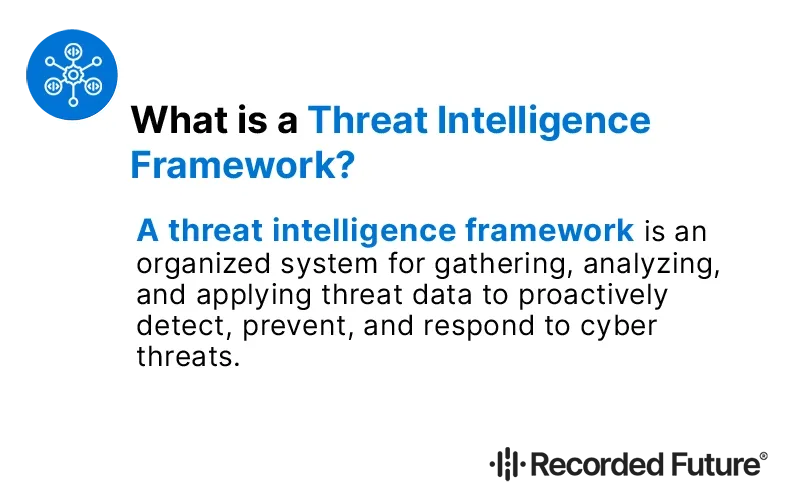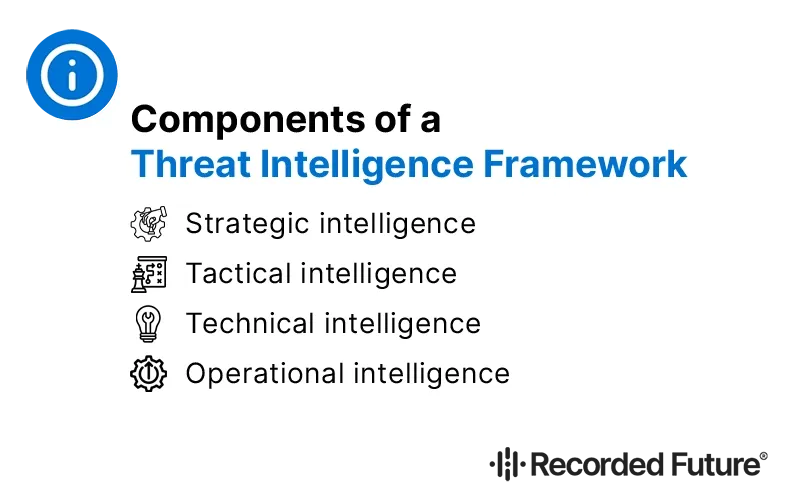What is a Threat Intelligence Framework?
Building a solid defense against cyber threats starts with having a reliable threat intelligence framework. It gives you the tools to gather and analyze data, helping you anticipate and stop attacks before they cause damage.
According to the 2024 State of Threat Intelligence Report, 90% of organizations plan to increase their investment in threat intelligence in 2025, signaling the growing importance of staying ahead of evolving threats. The report also highlights that 66% of security teams measure the success of their threat intelligence programs by enhanced detection rates, while 57% focus on reducing the number of incidents.
With this in mind, this article covers the basics of building a threat intelligence framework, including setting goals, using the right tools, and advanced tech to ensure your organization stays proactive, not reactive.
Top 3 Takeaways
- A structured threat intelligence framework is key to proactive defense against cyber threats, situational awareness and response times.
- Setting goals and priorities helps organizations focus threat intelligence on the right areas, overall cybersecurity effectiveness.
- Integrating AI and machine learning into threat intelligence frameworks makes threat detection and response way more efficient and accurate.
Why You Should Build a Threat Intelligence Framework
In today’s ever changing threat landscape a structured threat intelligence framework is worth its weight in gold. It gives organizations the knowledge and tools to anticipate and counter cyber attacks effectively, and be proactive against potential threats.
A full cyber threat intelligence framework means organizations can be proactive with their cybersecurity. They can help you detect and deal with potential threats before they get out of hand, using threat intelligence to stay one step ahead of the attackers and keep their defenses strong.

Proactive Defense Against Cyber Threats
Threat intelligence helps organizations proactively identify and defend against potential attacks by understanding the motivations and tactics of the threat actors. Early detection means pre-emptive action, reducing security breach risk. Knowing how vulnerabilities are being exploited means better protection of digital assets.
What is a Threat Intelligence Framework?
A threat intelligence framework is an organized system for gathering, analyzing, and applying threat data to proactively detect, prevent, and respond to cyber threats. A structured threat intelligence framework gives situational awareness and reduces response times to cyber attacks. This proactive approach means security teams can spot and respond to new threats quickly, overall cybersecurity resilience.
Combining threat intelligence with existing security processes gives you valuable insights for faster, better decision making. Timely information helps you prioritize alerts and spot potential threats so you can prevent and contain attacks more efficiently.
Threat intelligence feeds help you see trends and changes in the activities of cyber adversaries so you can improve decision making for security teams.
Reducing False Positives
A structured threat intelligence framework tunes your detection systems, reducing false positives. So you can focus on real threats without being swamped by false alarms.
By dealing with real major threats and not false positives organizations can improve overall security operations.
What are your Threat Intelligence Goals
Clear goals are key to integrating threat intelligence into security operations. Before you start collecting data you need to define specific objectives and benefits, so you’re aligned to your overall security strategy.
Defining goals means threat intelligence is focused on the right areas, defending against potential cyber threats. Clear goals also help you choose the right threat intelligence sources and tools so the data you collect is relevant and actionable.
What to Protect
Organizations need to decide which systems, data and digital assets to protect so they can prioritize their threat intelligence. Knowing the critical areas means security teams can focus on protecting the valuable assets and mitigating the big threats.
What to Expect from Threat Intelligence
Understanding the motivations and tactics of the threat actors through cyber threat intelligence means better defense strategies. Prioritizing vulnerability management and resource allocation means security measures address the biggest threats.
Expecting the benefits of threat intelligence means you can get the most out of your threat intelligence programme for asset protection.
Tactical Requirements
Tactical threat intelligence gives you specific detail on the tactics, techniques and procedures (TTP) of the threat actors so you can understand the attack vectors and develop defense strategies. Organizations should specify what tactics they want threat intelligence to support, such as vulnerability management and incident response, including the use of a threat intelligence platform.
So the threat intelligence framework can build on what you already have and stop attacks effectively.
What is in a Threat Intelligence Framework?
A good threat intelligence framework has several core components that work together to give you full security. These are:
Modern threat intelligence frameworks give you robust and scalable threat analysis capabilities.
Building a threat intelligence team means defining the required skill sets, qualifications, professional certifications and team structure. Using AI and advanced technology can greatly enhance a threat intelligence framework’s capabilities, make processes more efficient and turn data into insights.

Threat Intelligence Collection Tools
Choosing the right threat intelligence sources for your organization is key to collecting intelligence. These sources are open-source intelligence (OSINT), industry feeds and proprietary platforms. A good threat intelligence framework needs tools to collect, process and analyze data so security teams can focus on the big threats.
Cyber threat intelligence tools are platforms like forums, paste sites, blogs, social media, real-time alerts, dark web collection and technical collection. These fall into three categories: collect, process and analyze.
Data Processing and Enrichment
Data normalization standardized information from multiple sources for analysis. Correlating data points is key to finding patterns and insights in threat intelligence.
As the infosec team processes threat intelligence the data goes down and the value goes up.
Advanced Analytics and Machine Learning
Advanced analytics is key to getting insights from the vast amounts of threat intelligence data. Machine learning helps with cyber threat detection by analyzing large data sets to detect and prevent attacks. These technologies can spot anomalies and potential threats as they happen, greatly increasing the threat intelligence framework’s effectiveness.
Threat Intelligence and Existing Security Tools
Integrating threat intelligence with existing security tools is key to a joined up and effective cybersecurity strategy. Threat intelligence frameworks sit alongside broader cyber risk management strategies to give overall organizational cybersecurity. This integration removes blind spots and improves defenses so all cyber threats are covered.
Team alignment gives you better visibility into vulnerabilities and risk so you can respond to threats more easily. Technical expertise is required for integration and alignment so threat intelligence can be used within existing security tools.
Interoperability
Technical compatibility is key to a threat intelligence framework’s effectiveness. Standardizing protocols and data formats makes interoperability between different security systems so organizations can respond to threats and improve their overall cybersecurity.
Leveraging Forensic Expertise
Forensic experts give you the insights that make incident response more accurate. Tactical threat intelligence gives you specific insight into the attack methods used by the threat actors so you can counter the attacks. The right technology and forensic expertise is critical for threat intelligence.
Continuous Monitoring and Improvement
Proactive monitoring is key to adjusting security controls against evolving threats including emerging threats and advanced persistent threats. Regular updates to the threat intelligence framework keeps it relevant and effective against the ever changing cyber threats.
Integrating threat intelligence into daily monitoring and response activities improves overall security.
How to Implement a Threat Intelligence Framework
Implementing a threat intelligence framework involves several practical steps, starting with defining objectives and benefits. Collecting data is the first step, which involves OS, technical and human intelligence. Data processing techniques like sampling, validation, sorting, formatting and aggregation are key to getting valuable insights and turning data into intelligence.
Workshops and technical training is key to training your infosec team on the threat intelligence framework. Incident response teams use threat intelligence to understand the attacker methods and indicators of compromise (IoCs) so they can detect and identify potential incidents early.
Threat Vectors
Identifying threat vectors is key to understanding digital vulnerabilities and being able to counter cyber threats. Threat intelligence gives you operational context so you can do threat hunting.
Actionable Intelligence
**The purpose of gathering actionable intelligence is to stay up to date with the latest information on the threats. **A mix of open source and feeds is effective for gathering actionable intelligence. Tactical intelligence helps security teams refine their incident response playbooks so they can respond to evolving threats.
Data and Strategy
Data analysis in a threat intelligence framework turns raw threat data into intelligence. Once threat information is analyzed it’s shared with relevant stakeholders to improve security.
Adaptive incident response plans mean you can act fast and limit damage during a breach, with strategies and tactics changing based on the latest threat vectors.
Advanced Technology in Threat Intelligence
Advanced technologies like AI and machine learning are key to the evolution of threat intelligence frameworks. Integrating these technologies means more advanced, faster and proactive threat intelligence, and faster threat detection and response. Using advanced technology in threat intelligence means more efficiency, precision and proactive threat mitigation.
AI and machine learning collect data and detect patterns so you can identify anomalies and potential threats fast. These technologies let you stay ahead of the threats and keep your defenses one step ahead of the attackers.
Automation and Real Time Monitoring
Automated systems monitor cyber threats 24/7 so you can respond immediately. AI driven systems improve threat detection by learning normal behavior to identify unusual activity, reduce time to detect and respond to evolving threats.
Behavioral analysis in threat intelligence helps detect unusual activity that indicates threats and threat indicators so you can respond fast to cyber attacks.
Predictive Analytics
Predictive analytics is key to threat intelligence frameworks by forecasting future threats based on historical data and trends. Machine learning algorithms process vast amounts of data to detect patterns and anomalies relevant to cyber. Using these models you can predict threats and mitigate risk before they happen, and improve your overall security.
Natural Language Processing (NLP)
Natural Language Processing (NLP) is key to analyzing unstructured data in threat intelligence frameworks. NLP processes data from multiple sources like forums, social media and technical reports and extracts relevant information that adds to threat intelligence.
With AI this technology helps you stay ahead by understanding and predicting threat actor activity.
Recorded Future AI: Elevating Threat Intelligence
Recorded Future's AI technology takes threat intelligence to the next level by integrating automation, advanced analytics, and machine learning to deliver real-time insights. This enterprise-grade solution not only accelerates threat detection and response but also continuously processes vast data sets to enhance the accuracy and depth of intelligence.
By leveraging Recorded Future's AI, organizations gain actionable insights that allow them to anticipate threats, prioritize vulnerabilities, and respond proactively. This ensures that defenses stay one step ahead of cyber attackers, providing a crucial edge in today’s evolving threat landscape.
Related Questions
Why do I need a threat intelligence framework?
A threat intelligence framework is important for defending against cyber threats as it helps with decision making and reduces false positives and overall security.
What are the building blocks of a threat intelligence framework?
The building blocks of a threat intelligence framework are threat intelligence collection tools, data processing and enrichment and advanced analytics and machine learning. They work together to improve overall security.
How do I integrate threat intelligence with my existing security tools?
You can integrate threat intelligence with your existing security tools by ensuring interoperability, leveraging forensic expertise and continuous monitoring and improvement. This will improve your overall security and response to threats.
What role do advanced tech play in threat intelligence?
Advanced tech like AI, machine learning and natural language processing are key in threat intelligence as they automate data collection, detect patterns and enable real time monitoring and predictive analytics. This improves overall threat detection system effectiveness and response.
What do I do to build a threat intelligence framework?
You should identify threat vectors, gather intelligence, and analyze data to develop security strategies and incident response plans. That’s how you build a threat intelligence framework.
Conclusion
A threat intelligence framework is key to proactive security. By understanding threat intelligence, setting goals, integrating advanced technology and continuously improving you can mitigate risk and stay ahead of the threats.
To see how Recorded Future’s advanced threat intelligence can transform your security strategy, book a demo and experience proactive threat detection and mitigation firsthand.

Esteban is an IT professional with over 20 years of experience, specializing in hardening systems and networks, leading blue team operations, and conducting thorough attack surface analysis to bolster cybersecurity defenses. He's also a skilled marketing expert, specializing in content strategy, technical SEO, and conversion rate optimization. His career includes roles as Security Researcher and Head of Marketing at SecurityTrails, before joining the team at Recorded Future.
Related News & Research



